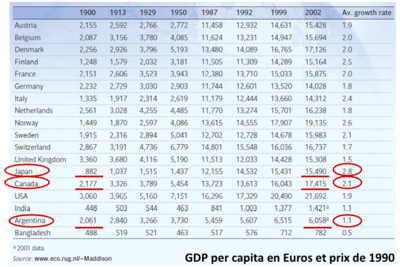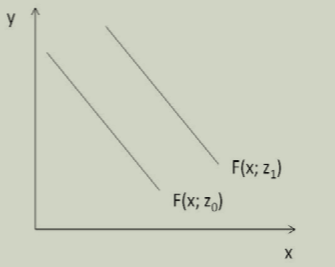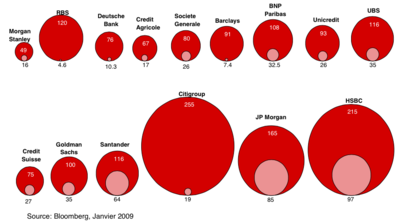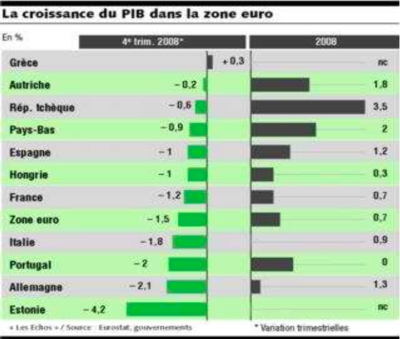Introductory aspects of macroeconomics
| Professeur(s) | |
|---|---|
| Cours | Introduction to Macroeconomics |
Lectures
- Introductory aspects of macroeconomics
- Gross Domestic Product (GDP)
- Consumer Price Index (CPI)
- Production and economic growth
- Unemployment
- Financial Market
- The monetary system
- Monetary growth and inflation
- Open Macroeconomics: Basic Concepts
- Open Macroeconomics: the Exchange Rate
- Equilibrium in an open economy
- The Keynesian approach and the IS-LM model
- Aggregate demand and supply
- The impact of monetary and fiscal policies
- Trade-off between inflation and unemployment
- Response to the 2008 Financial Crisis and International Cooperation
What is macroeconomics? Definitions and main macroeconomic aggregates[modifier | modifier le wikicode]
Domain[modifier | modifier le wikicode]
There are two main distinct but nevertheless complementary fields:
The micro-economy focuses on economic agents: consumers, savers, investors, entrepreneurs, governments, trying to understand:
- their behaviors / decisions, and their implications;
- their interactions in the different markets (goods, services, labour, capital).
Macroeconomics looks at the economy as a whole. It focuses on the major aggregates: savings, consumption, growth, inflation, unemployment, trying to understand:
- the determinants of their evolution;
- the interactions between the different aggregates.
NB: In macroeconomics, the behaviour of all economic agents is "'more than"' the sum of their individual actions and their consequences on the markets ("amplified" effects). Cf. the savings paradox
Questions[modifier | modifier le wikicode]
John Maynard Keynes' (1936) book The General Theory of Employment, Interest and Money is often seen as the starting point for the discipline. Keynes takes his insiperation from the Great Depression of the 1930s. Before that, the classical economic model did not foresee market failures and therefore there was no need for macroeconomics. The best that governments as well as economists could do was to look and not intervene in the economic system.
So, there are some typical questions of macroeconomics:
- How do you measure economic activity?
- Why do we see fluctuations in economic activity?
- What can be done to avoid excessive fluctuations?
- Why do we sometimes want to slow down the economy?
- Why do prices rise faster in some periods than others?
- What can the government do to ensure full employment?
- Why not keep injecting money in times of crisis?
The main variables[modifier | modifier le wikicode]
The main macroeconomic variables are :
- Real or nominal Gross Domestic Product (GDP);
- the unemployment rate (proportion of unemployed workers);
- the inflation rate (rate of price increases over time);
- the interest rate.
They are studied at one point in time and through time. Other important indicators include wages, exports, exchange rates and stock market indices.
It is also necessary to differentiate the notion of stock from that of flow:
- a stock is a quantity measured at a point in time.
- a flow is a quantity measured during a certain interval. In other words, it is the evolution of the stock variable.
For example, a person's wealth is a stock, but his or her income is a flow; the number of unemployed is a stock, but the number of people losing their jobs is a flow; government debt is a stock, but the deficit is a flow.
The economic circuit[modifier | modifier le wikicode]
The State as an economic actor[modifier | modifier le wikicode]
According to the first welfare theorem, competitive market allocation is optimal Pareto (or, in other words, the competitive equilibrium is efficient) making state intervention unnecessary and undesirable. BUT, this is true only under certain conditions, including no market failures, no uncertainty, no externalities, etc., and no market failures. Moreover, market allocation could be considered unfair by society leading to redistributive policies.
The market economy as such does not exist in reality and some situations require state intervention.
State intervention can be grouped under three functions:
- The allocation function;
- The distribution function;
- The stabilization function.
Functions of the State[modifier | modifier le wikicode]
The allocation function: there are market failures that lead to sub-optimal resource allocation. The State will intervene to change this allocation, for example by making goods and services available to society as a whole (public goods), financed by taxes or borrowing. Examples include national defence and public transport.
The distribution function: since the distribution of income and wealth is very unequal, the state is called upon to intervene according to standards of equity (defined by society). The aim is a redistribution of income and wealth. For example, the state can give allowances, introduce a minimum wage or have progressive income taxation.
The stabilisation function: the state can intervene to ensure the overall balance of the economy, avoiding unemployment and inflation as much as possible and having a balanced balance of payments. Its main instrument is fiscal policy. It can also intervene indirectly through the central bank by means of monetary policy.
The business cycle[modifier | modifier le wikicode]
A business cycle is a short-term alternation of short-term declines and increases in economic activity :
- Recessions (or contractions in activity): periods of declining economic activity where output and employment fall ;
- Expansions (or recoveries of activity): periods of increase in economic activity where output and employment rise ;
- Peak activity: the point at which the economy goes from expansion to recession;
- Activity troughs: the point at which the economy moves from recession to expansion.
Growth Policies[modifier | modifier le wikicode]
A growth policy is a trend towards a sustained increase in production. It is a relatively modern phenomenon dating from the 19th century and even beyond for a large part of countries.
A measure of the standard of living is the average income or GDP per capita of the economy.
Differences in living standards between countries are mainly explained by productivity differentials (even very small ones):
- The accumulation of physical and human capital increases productivity;
- economic policies and institutions also play a very important role.
Croissance à long terme[modifier | modifier le wikicode]
Un petit écart dans le taux de croissance du PIB peut faire une grande différence à long terme.
Two Great Schools[modifier | modifier le wikicode]
In the United States, a distinction is made between "saltwater" economists (Harvard, MIT, Stanford and Berkeley) versus "freshwater" economists (Chicago, Rochester, Minnesota).[11].
The Keynesians are rather salt water and think that markets don't always work properly and that governments must use economic policies to try to avoid recessions or excessive accelerations.
Monetarists and real business cycle economists are more freshwater people and think that the failures of governments are much more important than the failures of markets (political capture or inefficient bureaucracies). Monetarists argue that economic policy interventions are only effective if they are unexpected. Milton Friedman (Nobel Prize winner in 1976) is their "guru". Economists in the real business cycle find that government measures are counterproductive and distorting. Hayek (Nobel Prize in 1974) and Prescott and Kydland (Nobel Prize in 2004) are their "gurus".
Thinking like an economist[modifier | modifier le wikicode]
Methodological approaches[modifier | modifier le wikicode]
A distinction is made between positive and normative analyses :
- positive analysis: understanding what is. Positive analysis describes the way the world works (scientific approach to economics: it can be tested by comparing the analysis with the data).
- Normative analysis: studying what should be. Normative analysis prescribes the way the world works (the "policy-maker" approach: it is based on personal views, ideologies, value judgements).
For example, « Economic growth of 3% is needed this year », « Economic growth of 3% is needed to reduce unemployment by 4%. » or « The United States is richer and more developed than India because it has a higher GNP per capita. ».
The role of business models[modifier | modifier le wikicode]
An economic model is a working tool, i.e. a simplification of reality. Economic models are not "realistic" and they should not be. A model must simplify reality enough to understand what is happening and show the essential relationships between economic variables.
There is not ONE "correct" model, the role of testable assumptions must be emphasized.
A distinction must be made between the notions of exogenous and endogenous variables :
- exogenous variables: of origin outside the model;
- endogenous variables: explained, generated by the model.
The structuring of a model takes the following form:
- postulates + mathematical form (= simple language!) allowing to follow the logical implications and to find a solution + testable predictions.
The functioning of the scientific approach is as follows:
- observation → model → observation again
As in all sciences, the starting point is observation and modelling, with assumptions that simplify reality but are necessary to understand economic mechanisms. If the model has assumptions that are too detailed and realistic, it quickly becomes complex and without predictive power (as if). The most important thing is the predictive power, even if the assumptions seem unrealistic. Next, the models and their predictions are tested against the reality of the data. If they are not verified, the assumptions are corrected and we start again. The difference with hard science is that economists don't have a laboratory in which to conduct experiments. Their laboratory is the world: they have to look for 'natural' experiments.
How a graphic works[modifier | modifier le wikicode]
In the majority of cases we will give a graphical representation of the economic models we will analyze.
Care must be taken not to confuse the movement along a curve with the movement of the curve itself. If we have three variables, , and , and y is a function of and , = , in the usual two-dimensional graphs we can represent only two of the three variables. If we put and on the axes, the relation between these two variables is drawn assuming constant (in general we separate with a semicolon the variable assumed to be constant).
For example, the inverse relationship between and and the direct relationship between and (think of an inverse demand function where is price, is quantity demanded and is income). The variation of is a movement along the curve and the variation of is by moving the curve.
Causality: relinder[modifier | modifier le wikicode]
Graphical representation is a very useful tool to describe the relationships between economic variables, BUT beware of statistical illusions!
There is a risk of naively interpreting a simple correlation between variables as a causal relationship. For example, and are represented by a point cloud with an apparently positive slope. This does not necessarily mean that "cause" ! There may be a third hidden variable correlated simultaneously with and and causing them both.
This may reverse the direction of causality between variables. For example, countries under IMF (International Monetary Fund) programs have very high unemployment rates and incidence of poverty. This does not mean that IMF interventions cause poverty and unemployment! Rather, the causality goes in the opposite direction: from the economy in crisis to IMF intervention, not the other way around (it is because the economy is doing badly that the IMF is called upon to intervene).
The Study of Macroeconomics and the Economic Crisis of 2008[modifier | modifier le wikicode]
The 2008 crisis[modifier | modifier le wikicode]
- Market value as of January 2009, $billion
- Market value at Q2 2007, $bn.
Usefulness of macroeconomics[modifier | modifier le wikicode]
What is the point of macroeconomics if the current crisis could not be avoided? What is the point of medicine if we keep getting sick?
The study of macroeconomics makes it possible to understand what are the best ways to get out of the crisis quickly and cheaply.
- Is a recovery through consumption (with reductions in consumption taxes) a good thing?
- Is it better to boost the economy through investment?
- Why is international cooperation important?
Summary[modifier | modifier le wikicode]
Macroeconomics is the study of the relationships between major economic aggregates. Its objective is to understand how fluctuations in the economic performance of countries can be avoided and their living standards improved. Macroeconomics uses a scientific approach to analyzing reality and uses models to simplify reality and make predictions.
The most observed macroeconomic variables are gross domestic product, unemployment rate, interest rate, inflation rate.
The State intervenes in economic life with an allocation, distribution and stabilization function. It also puts in place measures that can influence the long-term growth rate of countries and thus the standard of living.
The study of macroeconomics does not help to avoid economic crises, but serves to understand what are the best ways to get out of the crisis quickly and cheaply.
Annexes[modifier | modifier le wikicode]
- “Macroeconomics.” Investopedia.
- Introduction to the Macroeconomic Perspective - BC Open Textbooks
- Introduction to Macroeconomics: Lecture Notes by Robert M. Kunst. 2006
- Cheng Chen Scho. Introduction to Macroeconomics. The University of Hong Kong
- “International Monetary Fund.” International Organization, vol. 1, no. 1, 1947, pp. 124–125. JSTOR, https://www.jstor.org/stable/2703527.
- The other-worldly philosophers, The Economist, 16.07.2009
References[modifier | modifier le wikicode]
- ↑ Page personnelle de Federica Sbergami sur le site de l'Université de Genève
- ↑ Page personnelle de Federica Sbergami sur le site de l'Université de Neuchâtel
- ↑ Page personnelle de Federica Sbergami sur Research Gate
- ↑ Researchgate.net - Nicolas Maystre
- ↑ Google Scholar - Nicolas Maystre
- ↑ VOX, CEPR Policy Portal - Nicolas Maystre
- ↑ Nicolas Maystre's webpage
- ↑ Cairn.info - Nicolas Maystre
- ↑ Linkedin - Nicolas Maystre
- ↑ Academia.edu - Nicolas Maystre
- ↑ The Economist, 16.07.2009











